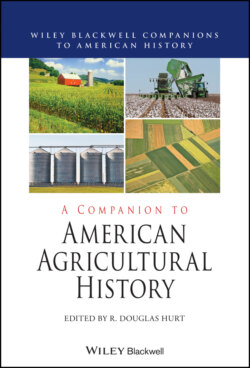Читать книгу A Companion to American Agricultural History - Группа авторов - Страница 20
The Pacific Northwest
ОглавлениеThe Pacific Northwest, which includes the Northwest Coast and adjacent interior Columbia Plateau, was formerly considered a region where complex, sedentary hunter-gatherers took advantage of rich marine resources but did not engage in agricultural pursuits prior to introduction of Old World crops (see Deur 2002a and 2002b for good discussions of how this paradigm became entrenched). Recorded observations of human-engineered planting beds, as well as propagation of both tobacco (Nicotiana quadrivalvis) and economically important root vegetables failed to alter the statuses of Northwest Coast societies in academic classification schemes wherein agriculture was narrowly defined as large-scale production of unmistakably domesticated plants. Recent attention to the elaborate infrastructure, considerable amount of labor, and high productivity of the cultivated plants and landscapes has validated usage of the terms “garden,” “cultivation,” and “food production,” as opposed to “foraging” in the sense of procurement of wild resources.
Ethnobotanists and historians who collaborate with or are themselves Indigenous experts provide rich accounts of copious quantities of camas (Camassia leichtlinii and C. quamash), balsamroot (Balsamorhiza sagittata), avalanche lily (Erythronium grandiflorum), and spring beauty (Claytonia lanceolata) harvested from intensively tended plots where soil conditions were improved and where storage organs were harvested only when they had reached their optimal stage in the maturation cycle. In many cases, axillary storage organs or other plant parts capable of regeneration were reburied after digging sticks were used to till the soil during harvest (Turner, Ignace, and Ignace 2000). Surveys and excavations of archaeological sites in British Columbia’s Interior Plateau document numerous earth oven pit features dating back to 1000 BCE. Earth ovens were used until historic times to bake starchy organs of camas and other root vegetables in order to convert inulin to digestible simple carbohydrates (Peacock and Turner 2000 ; Peacock 2008). After the introduction of cattle, bans on burning, and numerous other restrictions imposed on Canada’s First Peoples by colonial governments, it became impossible to find dense stands of camas with large bulbs, or other staple root foods whose productivity depended upon human management.
Archaeologists recently reported a concentration of charred camas bulbs found in the basal charcoal layer of an earth oven in the upper Fraser Valley of southwestern British Columbia (Lyons and Ritchie 2017). Although the site (DhRl78) is 150 miles outside the natural range of camas, it is within historical trading territory. The site was occupied for 2000 years up to the historic period, with four earth ovens clustered near several large plank houses and associated pithouses. Fragments of camas bulbs were found in three earth ovens, with one that yielded 415 whole or fragmentary camas bulbs and 1120 scales, dating to 400–500 CE. Lyons and Ritchie (2017) discuss alternate scenarios for the source of camas at this site: (i) acquisition by trade; and (ii) cultivation of transported stock in local gardens, evidence for which is not yet documented.
Coastal gardens built in estuarine zones for production of Pacific silverweed (Argentina anserina, formerly Potentilla anserina ssp. pacifica), springbank clover (Trifolium wormskjoldii), and other rhizomatous plants were elaborate and spatially extensive (Deur 2002a, 2005). Specialized digging tools were fashioned of yew wood, and houses for storage and processing were built nearby. Gardens were often bordered by rock walls and subdivided into family owned plots with interior boundaries clearly marked (Figure 1.5). Rock-free soils were created and fertilized with nutrient-rich marine and terrestrial detritus, and soils were aerated with digging sticks in work events distinct from actual planting and harvesting. Mounds were sometimes built to raise sections of the beds to optimal tidal level. These engineered gardens expanded the range and productive capacity of prized foods into the defensible territories of sedentary and competitive polities. Ethnographic sources document large amounts of rhizomes stored, traded, and consumed at feasts along the Northwest Coast, far beyond the potential of plants growing unaided in their narrow intertidal growth range. Deur (2002a) emphasizes that “Northwest Coast peoples harnessed the tremendous biotic output of one of the most productive terrestrial ecosystems, the midlatitudinal estuarine salt marsh, in a way that has few parallels elsewhere in the world.”
Figure 1.5 Map made by Douglas Deur of nineteenth-century Northwest Coast tidal flat gardens on northern Vancouver Island, based on map published by Franz Boas in 1934, after field reconnaissance by Deur (2005). Lines depict rock walls that surrounded individually owned plots where Pacific silverweed and springbank clover were cultivated. Note locations of digging houses in upper left. With the permission of Douglas Deur.
The remarkable discovery in 2007 of a submerged wapato (Sagittaria latifolia) garden dating to 3800 bp in British Columbia’s Fraser River valley constitutes “the first direct evidence of an engineered feature designed to facilitate wild plant food production among mid-to-late Holocene complex fisher-hunter-gatherers of the Northwest Coast” (Hoffman et al. 2016). This extensive rock-lined feature underlying a layer of well-preserved wapato tubers and wooden digging stick ends was uncovered during archaeological mitigation prior to bridge construction at site DhRp52. Recognition of similar examples of garden niche construction can be expected in the future, now that old classification systems relegating all West Coast peoples to the status of “foragers” have been dismantled.
